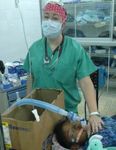Use of Stellate Ganglion Block to Treat Post-Traumatic Stress Disorder (PTSD) - Jennifer Hodge, BSN, RN, CCRN, SRNA Duke Nurse Anesthesia Program ...
←
→
Page content transcription
If your browser does not render page correctly, please read the page content below
Use of Stellate Ganglion Block
to Treat Post-Traumatic Stress
Disorder (PTSD)
Jennifer Hodge, BSN, RN, CCRN, SRNA
Duke Nurse Anesthesia Program
Class of 2014Objectives: • Define Post-Traumatic Stress Disorder (PTSD) and understand diagnostic criteria of this disorder. • Understand the prevalence of PTSD in the current population. • Discuss current pharmacological treatments for PTSD and their downfalls. • Correctly identify the anatomy of Stellate Ganglion. • Understand the theory and mechanism of action explaining how the stellate ganglion block can treat PTSD.
What is PTSD?
PTSD is a debilitating psychological
condition triggered by a major traumatic
event.
• Military Combat/War
• Violent personal assault
• Physical attack, mugging, rape, robbery, kidnapping
• Terrorist attacks
• 9/11, Oklahoma bombing, World Trade Center Bombing,
random public shootings
• Severe accidents
• Natural disasters
• Tsunami, earthquake, hurricanePTSD Diagnosis • Adults, adolescents, and children older than six years. • Multiple criteria must be met to receive diagnosis • Symptoms grouped into four different categories • Time frame and exclusion criteria also present
Criterion A:
Stressor
The person was exposed to: death, threatened death,
actual or threatened serious injury, or actual or
threatened sexual violence, as follows: (one required)
• Direct exposure
• Witnessing (in person)
• Indirectly, by learning that a close relative or friend
was exposed to trauma or death
• Repeated or extreme indirect exposure to aversive
details of the event(s), usually in the course of
professional duties.Criterion B:
Intrusion Symptoms
The traumatic event is persistently re-experienced in
the following way(s): (one required)
• Recurrent, involuntary, and intrusive memories.
• Traumatic nightmares.
• Dissociative reactions (e.g., flashbacks) which may
occur on a continuum from brief episodes to
complete loss of consciousness.
• Intense or prolonged distress after exposure to
traumatic reminders.
• Marked physiologic reactivity after exposure to
trauma-related stimuli.Criterion C:
Avoidance
Persistent effortful avoidance of distressing
trauma-related stimuli after the event: (one
required)
• Trauma-related thoughts or feelings.
• Trauma-related external reminders (e.g.,
people, places, conversations, activities,
objects, or situations).Criterion D: Negative Alterations in Cognition and Mood Negative alterations in cognition and mood that began or worsened after the traumatic event: (two required) • Inability to recall key features of the traumatic event • Persistent (and often distorted) negative beliefs and expectations about oneself or the world • Persistent distorted blame of self or others for causing the traumatic event or for resulting consequences • Persistent negative trauma-related emotions • Markedly diminished interest in (pre-traumatic) significant activities. • Feeling alienated from others • Constricted affect: persistent inability to experience positive emotions.
Criterion E:
Alterations in Arousal and Reactivity
Trauma-related alterations in arousal and reactivity
that began or worsened after the traumatic event:
(two required)
• Irritable or aggressive behavior
• Self-destructive or reckless behavior
• Hypervigilance
• Exaggerated startle response
• Problems in concentration
• Sleep disturbanceCriterion F:
Duration
Persistence of symptoms (in Criteria B, C, D, and E)
for more than one month.
Criterion G:
Functional Significance
Significant symptom-related distress or functional
impairment (e.g., social, occupational).
Criterion H: Exclusion
Disturbance is not due to medication, substance use, or
other illness.• Hypervigilance
• Exaggerated startle response
• Fear and anxiety
• Nightmares and flashbacks, including
sight, sound, and smell recollection
• Avoidance of recall situations
• Anger and irritability
• Guilt
• Depression
• Increased substance abuse
• Negative world viewTreatments Downfalls
• SSRIs- 1st line treatment • Duration of medication
• Zoloft, Paxil, Prozac, Celexa onset and “drop out”
• Seroquel- off label use • Somnolence & Fatigue
• Alpha1 antagonist • Sexual Dysfunction
• Prazosin
• Increased risk of suicide
• Alpha2 agonist
• Polypharmacy
• ClonidineMethylenedioxymethamphetamine
(MDMA)Stellate Ganglion Anatomy
Stellate Ganglion Block
• Infection • Bleeding • Intravascular injection • Subarachnoid injection • Local anesthetic toxicity • Pneumothorax • Allergic reaction Potential Complications
• Migraines • Complex Regional Pain Syndrome (CRPS) • Atypical face pain- Herpes Zoster • Hot flashes • Raynaud’s phenomenon • Craniofacial Hyperhidrosis • PTSD????? Current Uses for SGB
• Pseudorabies virus mapping in rats (Westerhaus & Loewy, 2001) • Connections established between Stellate Ganglion and insular and infralimbic cortical regions, hypothalmus and amygdala.
• 48 year old male • Victim of physical assault • One week post event- prescribed three medications • New symptoms at 23 days post event. • Relaxation therapy started but unsuccessful. • SGB done at day 55 post trauma Case Study 1
• Pt reported immediate decrease in anxiety • Change in symptoms and medication usage one week post SGB • Repeat of SGB with pulsed radiofrequency done at day 32 d/t return of symptoms • Follow up three months later, pt reported 90% improved Results
• Right sided SGB • Radiographic confirmation of right C6 transverse process • Skin localized and 25 ga. Quincke needle placed via anterior paratracheal approach under fluoroscopic guidance • 2 cc radio-opaque dye injected to visualize spread. • 7 cc of 0.5% Ropivicaine injected slowly after neg. aspirate • Pt monitored for horner’s syndrome, facial anhidrosis and temperature change in right hand x 15 mins. Procedure for Case Studies 2 & 3
46 yr male retired military involved in close range
combat event, where he was rendered unconscious from
an explosion.
• PCL score 76 out of 85
• 1 year psychiatric treatment prior to SGB
• On multiple medications:
• Zoloft, Seroquel, Trazadone, Effexor, and Ambien
• Experiencing multiple side effects from current medication
• somnolence, sexual dysfunction and auto accident
d/t falling asleep at wheel.
Case Study 2• Improvement 5 minutes after block placement • Anxiety score decreased from 8 to 2 • Tapered off all medications except Ambien • Able to sleep for 6-7 hrs per night • Nightmares diminished in both intensity & frequency • Remission for 3 mths, procedure repeated at 7 mths d/t return of symptoms and PCL of 67. • 4 months after 2nd procedure- off all psychotropic meds and PCL score of 34 Results
36 yr. old active duty male involved in Battle of Fallujah during Operation Iraqi Freedom. • PCL score of 54 • 1 year psychiatric care prior to SGB • Medications • Mirtazapine, Ambien and Zoloft Case Study 3
• Immediate improvement in anxiety levels post SGB • PCL score of 24 which remained consistent at 7 month follow up • Discontinued all medications with resolution of adverse side effects Results
The Future??
References
• (2010). In search of an effective treatment for combat-related post-traumatic stress disorder (ptsd): Can
stellate ganglion block be the answer?. World Institute of Pain, 10(4), 265-266.
• Alleva, E., Petruzzi, S., Cirulli, F., & Aloe, L. (1996). NGF regulatory role in stress and coping of rodents and
humans. Pharmacology Biochemistry and Behavior, 1(54), 65-72
• Freidman, M.J., Resick, P.A., Bryant, R.A., Brewin, C.R. (2010). Considering PTSD for DSM-5. Depression
and Anxiety, 1-20. DOI 10.1002/da.20767
• Lipov, E. G., Joshi, J. R., Sanders, S., & Slavin, K. V. (2009). A unifying theory linking the prolonged
efficacy of the stellate ganglion block for the treatment of chronic regional pain syndrome (CRPS), hot flashes
and posttraumatic stress disorder (PTSD), Medical Hypotheses, 72, 657-661.
• Lipov, E., Kelzenberg, B., Rothfeld, C., & Abdi, S. (2012). Modulation of NGF by cortisol and the stellate
ganglion block-is this the missing link between memory consolidation and PTSD?. Medical Hypotheses, 79,
750-753.
• Lipov, E., Kelzenberg, B., (2012). Sympathetic system modulation to treat post-traumatic stress disorder
(PTSD): A review of clinical evidence and neurobiology. Journal of Affective Disorders, 1-3(142), 1-5.
• Lipov, E.G., Lipov, S., Sanders, S.E., Siroko, M.K. (2008). Letter to the Editor: Cervical Symptathetic
Blockade in a Patient with Post-Traumatic Stress Disorder: A Case Report. Annals of Clinical Psychiatry,
20(4), 227-228.
• Mulvaney, S.W., McLean, B., Leeuw, J.D. (2010). The Use of Stellate Ganglion Block in the Treatment of
Panic/Anxiety Symptoms with Combat-Related Post-Traumatic Stress Disorder; Preliminary Results of Long-
Term Follow up: A Case Study. World Institute of Pain, 4(10), 359-365.
• Westerhaus, M.J., Loewry, A.D., (2001). Central Representation of the sympathetic nervous system in the
cerebral cortex. Brain Research. 903, 117-127.You can also read



























































